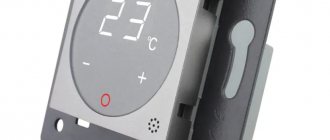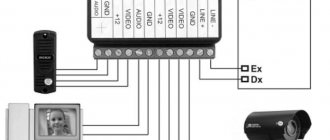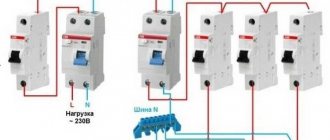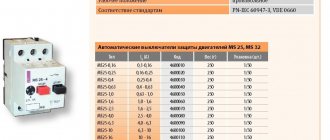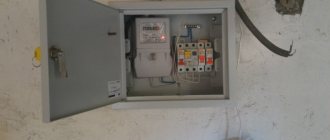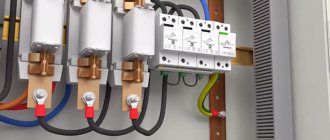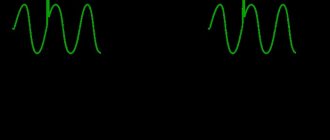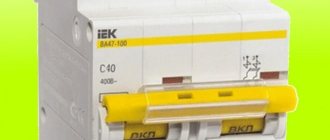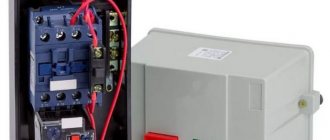A circuit breaker or circuit breaker is a switching device that conducts currents under normal conditions in a circuit and automatically turns off the supply of electricity from the mains to the consumer in the event of a short circuit or overload; you can also turn the circuit on and off manually.
The main difference between a two-pole machine and a single-pole one is the presence of the machine both in phase and at zero, that is, on two poles. Moreover, when switching off, both phase and zero are simultaneously disconnected, thanks to the common cocking handle. Used for mounting a single-phase circuit. For a three-phase circuit, you need to use 3- and 4-pole circuit breakers.
Application area
- As introductory circuit breakers. This is the most popular method of application. By simultaneously disconnecting the phase and zero, maximum safety is ensured when working in the circuit, because a complete de-energization occurs. In addition, according to the new rules of Electrical Installations (clause 6.6.28, clause 3.1.18), the operation of single-pole circuit breakers at the input is prohibited.
- To protect a separate group of electricity consumers. Disabling the two-pole circuit breaker will prevent the operation of the RCD (Residual Current Device - designed for protection against differential currents) in the event of erroneous contact between zero and phase during repair work in circuits under load. It also makes it easier to find a branch with a fault when an RCD is triggered by a current leak to the ground.
- For protecting and controlling circuits with simultaneous power supply. For example, when connecting a heat gun, a phase is supplied through one pole of the machine to the heating elements, and through the other pole, a phase is supplied to the fan motor. If one equipment turns off, the other will also turn off, which will prevent the possibility of the heating elements operating without cooling.
Features of the operation of single-pole and double-pole AV
The essence of the work of each of these types, in general, can be understood from the name. A single-pole circuit breaker is designed to disconnect one line. A two-terminal network differs from it in that it controls the working process in two lines simultaneously and compares the parameters of the electron flow, determining whether it corresponds to the value that is permissible for the correct operation of the network. If these indicators are exceeded, the device is triggered, turning off the power to both lines simultaneously.
Some readers may have a question: is it possible to replace a two-pole circuit breaker with a pair of single-pole switches? This should not be done under any circumstances. Indeed, in a device with two poles, its elements are connected not only by a common lever, but also by a locking mechanism.
This means that if a problem occurs, they will turn off simultaneously, and in a pair of single-pole circuit breakers independent of each other, only one circuit breaker will work. In this case, electric current will still be supplied to the faulty circuit through the switched on device, which may cause a fire in the wiring. You can see the attempts at unification in the following video:
The difference between these two types of safety switch lies in the design of the release. A two-pole circuit breaker must have a tripping element, the configuration of which allows both parts of the device to be turned off simultaneously, both during automatic operation and during manual operation.
If the electrical circuit in the apartment is single-circuit, then there is no need to install a two-pole circuit breaker in it, since there is no need to simultaneously protect different segments of the room. But in the case when complex equipment is installed in one of the rooms, which, due to its parameters, cannot be included in one common circuit, you cannot do without a multi-terminal network.
For clarity, consider this example. Let's say there are two lines in the home network, one of which is connected to a complex device, and it is supplied with power through a rectifier.
If there is a violation in one of the lines, then as a result of its disconnection, the supply of power to one circuit will cause a voltage surge, and therefore an increase in other parameters. If the AV of the second line does not operate in a timely manner, the result will be failure of the device, and possibly a cable fire. That is why such a network must be protected by a 2-pole device.
What will happen in the opposite situation, when they try to disconnect a multi-pole circuit breaker, in the video:
Advantages of application over single-pole circuit breakers
Let's consider a situation where someone confused the phase with zero. Then, when the single-pole circuit breaker is turned off, the zero line is disconnected, and the phase remains in the circuit. A person, thinking that he has protected himself by turning off the machine, starts working and receives an electric shock. To prevent this from happening, after disconnecting the single-pole circuit breaker, you need to check the absence of voltage in the circuit with an indicator. But it is still safer to use a two-pole circuit breaker, which will completely de-energize the circuit.
In the case when the RCD has tripped, it is necessary to find a fault in the circuit. First of all, turn off all electrical appliances from the sockets. If this does not produce results, the branches of the circuit are switched off sequentially, but both zero and phase must be disconnected. A single-pole circuit breaker does not provide this opportunity. You will have to remove the zero on the bus, which is problematic, since it requires dialing to find the right wire. A two-pole machine copes with this task perfectly.
Thus, the advantages:
- Safety - the electrical circuit is completely broken.
- Ease of troubleshooting.
Advantages and disadvantages
Two-pole circuit breakers provide control of lines with single-phase power supply, as well as protection of equipment operating in three-phase circuits.
The advantages of these devices include:
- reliable protection of homes, offices and industrial premises from network surges;
- the ability to control the power of individual electrical appliances and installations;
- ease of installation and maintenance. Two-pole AVs are ideal for branching and structuring wiring in the electrical supply of premises.
Of course, the main advantage is that a two-pole circuit breaker simultaneously de-energizes two conductors, regardless of which of them the accident occurred. This guarantees a complete absence of voltage in the protective conductors.
Disadvantages include:
- there is a possibility of cable breakdown when two loaded lines are turned on simultaneously;
- in rare cases, if the thermal release fails, an arbitrary power outage is possible even in the rated voltage mode;
- the need to select two-pole circuit breakers in accordance with the design parameters of the network. If the sensitivity of the switch is too high, it will often trip without good reason, and if the speed of reaction to an unusual situation is too low, the machine will not notice the network overload.
Thanks to the unique advantages, the use of two-pole switches is justified even taking into account the existing likelihood of the manifestation of these disadvantages.
Machine device
The circuit breaker is a plastic case with contacts and an on/off handle. The working part is located inside. The stripped wire is inserted into the terminals and clamped with a screw. When cocked, the power contacts are closed - the handle position is “On”. The handle is connected to a cocking mechanism, which, in turn, moves the power contacts. Electromagnetic and thermal splitters ensure that the machine is switched off in case of abnormal circuit conditions. The arc chute prevents combustion and quickly extinguishes the arc. The exhaust channel removes combustion gases from the housing.
Safety precautions when installing two-pole circuit breakers
Electrical safety rules for installing protective devices on two poles generally do not differ from general measures when installing other electrical devices. They are:
- Installation must be carried out by two people, so that in the event of an electric shock, one of the technicians can provide timely assistance to the victim.
- To protect against electric shock, you must use dielectric mats and protective gloves.
- Before starting any work on electrical networks, you must obtain special permission.
Connection diagram
It is proposed to consider the connection diagram of a two-pole circuit breaker.
Here VA 47-63 2/50A is an introductory two-pole circuit breaker. It completely de-energizes the entire circuit if necessary. A meter and an RCD are connected behind it. Next, a connection diagram for a number of single-pole circuit breakers is used. They are installed only on phase wires, and neutral wires are distributed via a bus.
There is a connection diagram for a number of two-pole circuit breakers, each protecting its own branch.
The RCD is connected first at the input, then two rows of two-pole switches. The neutral wire is blue, the phase wire is red, and the grounding distributed using a grounding bus is yellow. In this way, each branch of the circuit is protected.
Manufacturers and brands
Single-pole circuit breaker ABB 1P C25
Before choosing and buying a C25 circuit breaker, you should familiarize yourself with the companies that represent them and the price. Well-known instrument manufacturers:
- The Swedish-Swiss company ABB is rightfully considered the leader in the market of electrical products of this class.
- Circuit breakers from Legrand (France) are not inferior in quality to the previous brand, and the prices are approximately comparable in value.
- The products of another French company (Schneider Electric) are well known to domestic consumers, who speak highly of this product.
The price of a C25 assault rifle on the domestic market ranges from 100 rubles. up to 100 thousand rubles depending on the number of poles, company and brand.
Installation
How to properly install circuit breakers in an electrical panel? First, DIN rails are screwed into it with self-tapping screws - these are metal plates, onto which all automatic devices and RCDs are then attached. The length of the DIN rail can be adjusted using a hacksaw. In addition, distribution terminal strips are attached to the shield. They can be for neutral wires and separately for ground wires. The modern configuration of the tires allows them to be mounted directly on a DIN rail.
Installing a two-pole circuit breaker on a DIN rail is very simple. Using a flat-head screwdriver, you need to pull out the snap-on bracket on the top of the case, attach the machine to the DIN rail and release the fastener. Removal is also carried out. According to the rules, the introductory machine is installed in the upper left corner.
Next you need to connect the wires. The scheme must be strictly adhered to. The phase and neutral input wires are connected to the two-pole circuit breaker from above, and the wires from below are discharged into the circuit. It is important not to confuse: the entrance is from above, the exit is from below, otherwise the machine may fail and will not perform its functions.
You can connect machines using jumpers made of copper wire of the same cross-section as the circuit wire. Jumpers are required to connect two-pole circuit breakers in a row. And also with the help of combs - these are insulated buses, used to connect single-pole circuit breakers.
The ends of the wires are stripped using a special stripper tool or a sharp knife. Then they crimp the cable lugs with a hand tool using a crimper. If there is no such equipment, then you can simply tin the ends with a soldering iron using rosin and tin. When connecting wires to machines, it is necessary to tighten the bolts firmly with a screwdriver so that weak contact does not cause heating and damage to conductive materials.
The grounding wire always passes past the machines directly to the grounding bus. The neutral wires are connected to the neutral bus.
How to choose a two-terminal network?
In order for a circuit breaker to fully provide the necessary protection, it is necessary to carefully select it. The main thing is not to make a mistake with the denomination. To do this, you need to know the rated load that you plan to connect to the device.
The current in the circuit protected by the circuit breaker is calculated using the formula: I = P / U, where P is the rated load, and U is the network voltage.
For example: if a 400 W refrigerator, a 1500 W electric kettle and two 100 W light bulbs are connected to the device, then P = 400 W + 1500 W + 2 × 100 = 2100 W. At a voltage of 220 V, the maximum current in the circuit will be equal to: I = 2100/220 = 9.55 A. The rating of the machine closest to this current is 10 A. But in the calculations, we have not yet taken into account the wiring resistance, which depends on the type of wires and their cross-section. Therefore, we buy a switch with an operating current of 16 amperes.
We provide a table that helps determine the network power to be taken into account when calculating current strength.
| Current strength | 1 | 2 | 3 | 4 | 5 | 6 | 8 | 10 | 16 | 20 | 25 | 32 | 40 | 50 | 63 | 80 | 100 | |
| Single-phase network power | 02 | 04 | 07 | 09 | 1,1 | 1,3 | 1,7 | 2,2 | 3,5 | 4,4 | 5,5 | 7 | 8,8 | 11 | 13,9 | 17,6 | 22 | |
| Wire sizes | copper | 1 | 1 | 1 | 1 | 1 | 1 | 1,5 | 1,5 | 1,5 | 2,5 | 4 | 6 | 10 | 10 | 16 | 25 | 35 |
| aluminum | 2,5 | 2,5 | 2,5 | 2,5 | 2,5 | 2,5 | 2,5 | 2,5 | 2,5 | 4 | 6 | 10 | 16 | 16 | 25 | 35 | 50 | |
Using the table, you can accurately calculate the necessary parameters of a two-pole circuit breaker.
As for the stores where you can buy them, focus on prices and product range. From the list of manufacturers we can recommend, for example, the Legrand brand.
Marking
Particular attention should be paid to the markings of machines.
There are special markings on the body of the machines:
- Rated current of the device (in amperes).
- Overload current group (operation current range).
- Maximum operating current or short circuit current (in amperes).
- Current limiting class (the higher the class, the higher the response speed during a short circuit).
- Graphic designation or schematic diagram of the device.
- Device series.
- The rated voltage at which the machine must be used.
Disadvantages of double-pole circuit breakers
Any device has weaknesses, and multi-pole network protection devices are no exception. Although two-terminal circuits have few negative properties, we still list them:
- When two lines are shorted at the same time, an electrical breakdown of the cable occurs.
- The thermal release occasionally fails, causing the mains power to be cut off even when it is in normal condition.
- As a result of an accident, the AV may break down along one of the lines, which will make it impossible to turn on the power even after troubleshooting.
- Multi-pole devices are more sensitive to mechanical damage compared to single switches.
Despite these disadvantages, protective devices that provide control over two lines are common and very popular. They allow you to secure the general network in the event of problems in the line to which powerful household appliances are connected.
